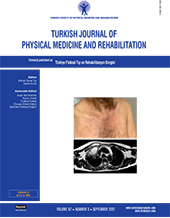Comparison of the functional and cardiovascular effects of home-based versus supervised hospital circuit training exercises in male wheelchair users with chronic paraplegia
2 Istanbul Faculty of Medicine, Sports Medicine, Istanbul, Turkey
3 Department of Physical Medicine and Rehabilitation, Istanbul University Istanbul Faculty of Medicine, Istanbul, Turkey DOI : 10.5606/tftrd.2021.6533 Objectives: The aim of this study was to compare the efficacy of home-based upper extremity circuit training exercises (CTEs) with supervised hospital program in male patients with traumatic complete paraplegia.
Patients and methods: Twenty men with paraplegia (mean age: 38±10.1 years; range, 30 to 43 years) between January 2007 and November 2007 were randomized into two groups. The first group had supervised hospital CTE program, whereas the second group had home-based CTE. The effects of the upper extremity CTE by using elastic bands 60 min per day, five days a week, for a total of eight weeks (70% maximal oxygen consumption [VO2max]) were examined. The Cybex was used for the isokinetic testing of the upper extremities. The VO2max and maximum heart rate (HR) were assessed using an arm ergometer. The Craig Handicap Report Technique Short Form (CHART-SF) was used for the evaluation of functional independence and mobility. Serum lipid profiles were measured.
Results: The mean injury duration was 7.9±2 years. The peak torque values of the upper extremities, VO2max, maximum HR, CHART-SF physical independence and mobility scores, and serum lipid profile were all improved in both groups (p<0.05). There were no significant differences in terms of the increase in the muscle strength and serum lipid levels between the groups (p>0.05). The improvement in the VO2max, physical independence, and mobility scores were greater in the supervised exercise group.
Conclusion: Upper extremity strength, cardiovascular endurance, and lipid profile were improved after supervised and home-based CTE in the men with paraplegia. Home-based exercise programs may be good alternatives to the hospital rehabilitation for this patient population.
Keywords : Exercise, male, maximal oxygen consumption, paraplegia, spinal cord injury, upper extremity, wheelchair

















